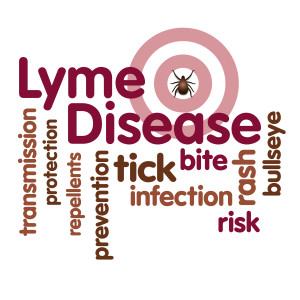 Lyme disease is a bacterial infection that is transmitted to humans through a bite from an infected blacklegged tick. These ticks can attach to any part of the body, but are most often found in hard-to-see areas such as the scalp, groin and armpits. The indications that you have contracted the disease are: headache, fever, fatigue and a rash.
Lyme disease is a bacterial infection that is transmitted to humans through a bite from an infected blacklegged tick. These ticks can attach to any part of the body, but are most often found in hard-to-see areas such as the scalp, groin and armpits. The indications that you have contracted the disease are: headache, fever, fatigue and a rash.
The disease can be eliminated by the administering of antibiotics. If left untreated, however, it can cause significant health issues. Facial paralysis, arthritis, fever, short term memory failure, nerve pain, dizziness and irregular heart beat can all happen if Lyme disease is not treated within the first 30 days of infection. These symptoms can greatly affect the individual’s life. That is why diagnosis and proper treatment are crucial.
According to the Center for Disease Control, in 2014, 96% of Lyme disease cases were found in the northeast and upper Midwest states. The areas being: Connecticut, Maine, New York, Pennsylvania, Wisconsin, New Jersey, Maryland, Massachusetts, Delaware, Rhode Island, Vermont, Virginia, and Minnesota. These states have large wooded areas where the blacklegged tick lives on its host animal the deer.
Ways to prevent exposure to Lyme disease:
- If spending time outside cover your skin and clothing with insect spray that contains the ingredient DEET® which deters ticks.
- Avoid wooded and high grassy areas
- Treat clothing and outdoor gear such as backpacks, sleeping bags and tents with sprays that contain permethrin.
- If time is spent in areas that are tick-prone, shower immediately upon returning. You may be able to catch ticks still crawling on you and not yet embedded into the skin.
- Carefully check all areas of the body for ticks after showering
- Pets are carriers for ticks and can transfer them to humans, so check Fido after a day outside in the yard.
- If a tick is found embedded into your skin, using Tweezers, carefully grab the tick as close to the skin as possible and pull straight out. Do not twist. It is important that you get the head of the tick out of the skin. Place the tick in a baggie where it can’t escape. Watch for signs of Lyme disease. If suspected there is an infection, go to your doctor and take the tick with you for testing.
Lyme disease can become a debilitating condition if not treated quickly. But, the good news is that it is preventable and, if caught early, can be cured.
Search for a physician through IPALC.org
Share on Facebook



 Southwest Florida Medicine.com is dedicated to bringing you the very best health information available today!
Subscribe or check back regularly!
Southwest Florida Medicine.com is dedicated to bringing you the very best health information available today!
Subscribe or check back regularly!